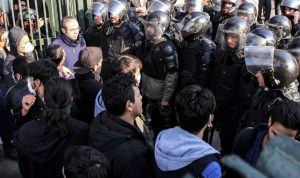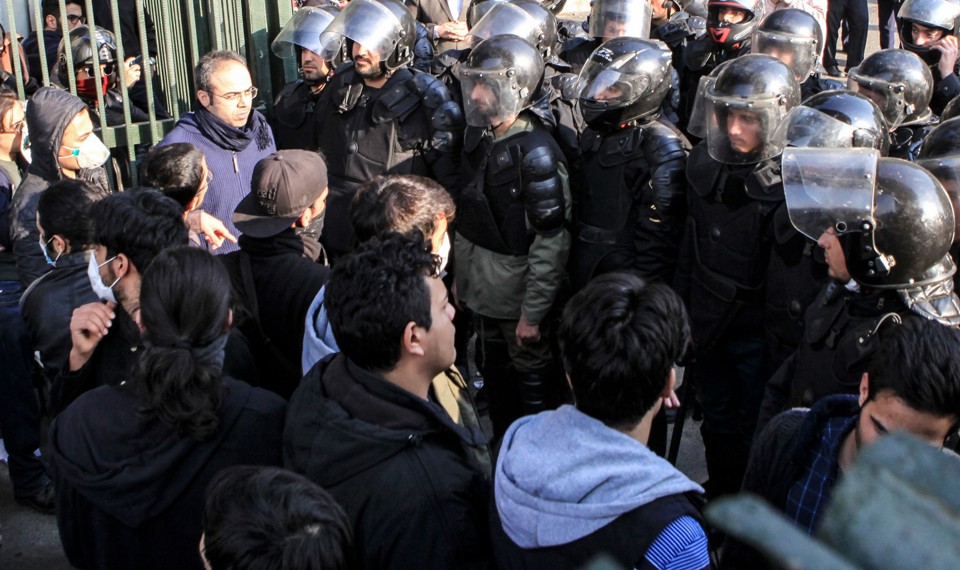 The Atlantic
The Atlantic
The president’s tweets about the recent protests are misleading and dangerous to protesters.

The protests that have rattled Iran this weekend are in many ways an echo of the near past. In the summer of 2009, millions of Iranians took to the streets to protest the reelection of President Mahmoud Ahmadinejad, whose rhetoric and policies had isolated their country for four years.
The opposition believed his reelection victory was fraudulent. They chanted slogans demanding a recount of the votes. Others denounced the regime and its highest authority, Supreme Leader Ayatollah Khamenei. Hardliners and security forces confronted the crowds with anti-riot gear and harsh condemnation, often labeling them agents of foreign powers. It was a huge moment and seemed, at the time, to portend an irreversible shift in geopolitics.
But the protests, now known as the Green Movement, died out after a few months. Some protesters left the country, others were arrested or killed. Mostly, they went back to their daily lives.
Now, Iran is experiencing the first large-scale unrests since the Green Movement faded. Since then, Iranians tackled their challenges at the ballot box rather than on the streets—in two presidential elections, both won by the moderate Hassan Rouhani; and in two parliamentary elections leading to the country’s legislative body being populated by more moderates and reformists. But familiar difficulties have returned. With the controversial nuclear deal—between Tehran and world powers, including the United States—failing to deliver economic recovery for the masses, many were starting to feel restless once again. In the weeks prior to the demonstrations, Iranians were complaining about the price of basic food items. Memes surfaced on social media, poking fun at the price of eggs.
Now that frustrations have spilled into the streets, the scene is reminiscent of what took place in Iran nine years ago. Some of the slogans chanted by protesters are identical. “Bullets, tanks, and Basijis are no longer effective,” “referendum, referendum, this is the people’s slogan,” and “death to the dictator” are among those recycled chants. Young protesters are again covering their faces to bring down and burn effigies of Khamenei. And just like in 2009, both protesters and security forces are attempting to leverage social media for their benefit. The apps Telegram and Instagram have been temporarily restricted by the Iranian government amid this week’s protests, the BBC reported.
Key figures within the regime have stepped in to take sides, with Rouhani calling on the regime to provide the protesters with a platform and to hear their voice. The protests, Rouhani explained in an appearance on state TV, aren’t simply about the economy but also transparency and corruption. At the same time, hardliners blame Rouhani for focusing his attention on building ties with the West and implementing the nuclear deal, instead of providing for his people. But as the world watches Iran, it’s paying attention to the United States, too.
What America says and does will have a large impact on what happens next.
Since the demonstrations started, President Trump has taken to Twitter on multiple occasions to comment. “The world is watching!” he tweeted on Friday. And also, “the good people of Iran want change, and, other than the vast military power of the United States, that Iran’s people are what their leaders fear the most.”
In one tweet, the president included a link to a video of his speech at the UN General Assembly in September, which was largely criticized by Iranians of all political persuasions as belligerent and disrespectful.
Then, on New Year’s eve, using language similar to his tweets about domestic matters, the President seemed to praise the protests, calling them “big,” and noting that “the people are finally getting wise as to how their money and wealth is being stolen and squandered on terrorism. Looks like they will not take it any longer.”
It isn’t surprising that Iran has captured Trump’s attention. After all, over the course of his first year in office, he has made it clear that the Islamic Republic holds an important place in his foreign policy agenda. And he’s undertaken to undo his predecessor’s nuclear deal with Tehran, removing the “carrots” from the “sticks and carrots” policy, and formulating an approach based exclusively on harsh rhetoric, threats, and coercion. But the president’s tweets are misleading and counterproductive.
Iranians aren’t “finally” waking up and “getting wise,” as Trump suggests. Instead, Iran has a dynamic and active civil society, which has created and embraced opportunities for reformation and progress for decades. From active participation in elections to various reform and protest movements, Iranians have tried to make their voices heard. Starting in the early 1900s, Iranians—then still known as Persians—fought for representation, accountability, and transparency. Later, various movements sought freedom and opportunities—including since the 1979 revolution. And many Iranians have paid for these ideals with their lives.
Unlike what President Trump suggests, the protests aren’t about Iran’s broader behavior and foreign policy. And they’re not about the regime’s support for terrorism. This isn’t to say that Iranians endorse their leadership’s positions, but that their main concern lies in the price of day-to-day items and goods, such as poultry and eggs, as well as unemployment and access to services.
The president’s tweets suggest he barely understands the country he’s repeatedly demonized. This is troublesome given how much influence he has on what happens next. The Trump administration has toughened America’s stance on Iran. Former National Security Advisor Michael Flynn put Tehran “on notice” during his brief tenure in the early days of the administration. And administration officials haven’t shied away from flirting with regime change as a tool of U.S. policy toward Iran, with Secretary of State Rex Tillerson admitting to viewing the support of “elements” within the country seeking a “peaceful” transition of power as an option.
But far from empowering the Iranian people, the Trump administration’s response to the protests serves to undermine their efforts. In 2009, upon request from the U.S. government, Twitter delayed a temporary shutdown to allow Iranians to use the platform for organization and communication. Today, the Trump administration should similarly work with social media platforms and media outlets to facilitate the flow of communication into and out of the country.
While, in principle, the protests can spark a more large-scale movement and deep change, they aren’t likely to do so. The appetite for fundamental power transition is simply lacking in Iran given the lack of viable alternatives and the fizzling out of the Arab Spring. Already in 2009, the protesters weren’t calling for regime change but reform. Today, unlike the Green Movement, the protesters aren’t organized and cohesive. And while earlier protesters had leaders to rally around and clear objectives to pursue, today’s protesters have neither.
Indeed, in summer 2009, at the peak of the Green Movement, I frequently heard from Iranians who’d decided to stay at home—despite opposing Ahmadinejad and viewing his reelection as fraudulent—that they didn’t want to provide the Americans with ammunition to attack their country. Today, hardliners are already trying to label protesters as foreign agents, as they did in 2009. And if Washington is viewed as actively interfering in Iranian affairs, it’ll at best deter Iranians from joining the movement and making their voices heard, and will at worst help the hardliners, undermine the protesters, and facilitate the crackdown against them.
https://www.theatlantic.com/international/archive/2018/01/donald-trump-doesnt-understand-whats-happening-in-iran/549440/



